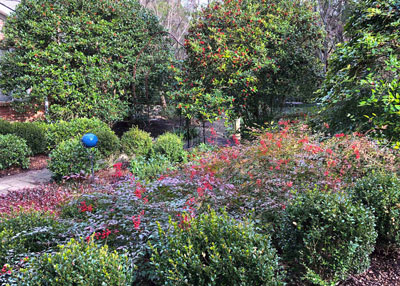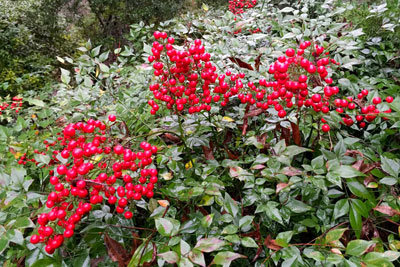Plant of the Week: Compact Nandina
I’ve always been a big fan of nandinas. I grew up mowing around them in College Station. But those were the big dogs – standard Nandina domestica, theoretically called “heavenly bamboo,” but everybody just called them “nandinas” because there was only the one kind and that common name sounded kinda goofy.

Then, somewhere 50 years ago, I began to see “compact nandinas” in nurseries. They might have been there longer, but I’d been away in Ohio getting college out of the way.
I started growing compact nandinas in my own landscape, and I soon found that they were, as Goldilocks said, “Just right.” I could maintain them at 36 inches height with just annual pruning. That was (and is) perfect for most landscaping uses.
Since then even shorter varieties of nandinas like Harbour Dwarf, Harbor Belle and Flirt have come into the market, and I love them, too, but I still come back to Compact nandina for bigger beds in my landscape.

Things you need to know…
Here is this plant’s quick bio list:
• Nandina domestica X ‘Compacta.’
• Original species native to Japan.
• U.S.D.A. Plant Hardiness Zones 6-10.
• Adapted to sun and shade, but has more fruit and better color in sun.
• Grows to 36-48 inches tall. 30-36 inches wide, although generally grown in clumps.
• Spreads by rhizomes (underground runners).
• Holds soil well on slopes.
• Unusual growth habit with upright stems and fine-textured evergreen leaves.
• Foliage is dark green all growing season, turning purple-maroon in winter.
• Clusters of bright orange-red berries all winter. (Berries may be toxic to cedar waxwings and should be pruned off by early February when the birds start their migrations north.)
A special tip on pruning nandinas…
Never prune a nandina part way down. If you have a stem that is growing too tall, cut it clear to the ground so it can send up new shoots. That will keep the plant full and compact.
Aim to prune the tallest half or two-thirds of the canes late every winter and you’ll be able to keep your “compact nandinas” truly full and compact.
If you have plants that have been improperly pruned for years, give it a try. Except, instead of pruning just half of the canes to the ground, cut most of them back completely. You’ll be amazed at the new shoots that will come roaring up from the roots. Your bed will be beautiful again!
Note: Some websites list nandinas as being invasive plants, but other highly respected university sites assign the word “rarely” to such discussions. I have not found them to be any more invasive than most of our other seed-producing landscape plants. They may produce chance seedlings occasionally, but usually not if we prune the fruit clusters off in late winter, as suggested, to prevent any ill effects to migrating birds.
